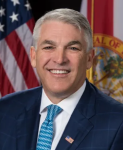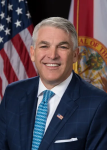Record-breaking Growth at Ports Brings Fresh Opportunities and Challenges

As many ports around North America have encountered robust growth in recent years, they have needed to work harder and smarter to accommodate that growth and ensure that they are equipped to take advantage of an array of new opportunities. Prioritizing planning, adjusting to changing circumstances, and making bold decisions have been not just advisable but necessary for port leaders and their teams.
The Port of Harlingen in Texas, Port Tampa Bay and the North Carolina State Ports Authority share how they have navigated enviable growth in recent years – and prepared themselves for growth in the years ahead.

Commodities Growth Leads to Major Gains
The Port of Harlingen in southeast Texas has experienced rapid growth over the last six years. Walker Smith, port director of the Port of Harlingen Authority, said the port has seen a 240% increase in tonnage moving through its facilities from fiscal year 2016-17 to fiscal year 21-22, growing from 996,079 to more than 3.2 million tons. From fiscal year 2017 to fiscal year 2021, the Port of Harlingen coordinated the service of a 95% increase in vessels on its existing waterway.
Expansion largely is attributable to commodities growth. As a result, Smith said the port is working toward the expansion of its turning basin to allow for more efficient and safer maneuverability of barge traffic and allow for an increase in traffic.

“Our biggest area of growth is from the refined petroleum products consumed in the Rio Grande Valley, and an even bigger growth in exporting fuels to Mexico,” Smith said. “Refined petroleum products make up about 85% of our total tonnage, followed by construction aggregates, sugar and agricultural products such as cotton and grain, as well as agricultural fertilizer used by area farmers.”
Smith said the need for refined petroleum increased in Mexico in recent years, and the port imports domestic fuel via barge and exports to Mexico by truck.
“During its peak, it is not unusual for between 350 and 400 trucks to move fuel from our terminals bound for Mexico,” Smith said. “This has meant growth in jobs, terminal space, and new money being pumped into our economy through the purchase of goods.”
Smith noted that growth in commodities translates to growth in economic impact. Based on studies done in 2018 and 2021, the port saw a 108% increase in those three years in total jobs created (direct, induced, indirect and related), a 111% increase in generated state tax revenue from $17 million to $36.3 million, a 68% increase in business revenue from $120 million to $202.4 million, and a 79% increase in economic activity from $1 billion to $1.79 billion from maritime cargo.

Cargo Diversity Spurs Growth
Meanwhile, Port Tampa Bay has seen significant growth across several lines of business. For instance, the port saw a 7% increase in cargo tonnage through its facilities during the fiscal year that ended in October. In particular, containerized cargo grew by 21% to 216,449 TEUs, and container tonnage was up by 30% to 1,088,327 tons. Juice was up by a striking 517% to 947,931 tons, cement increased by 13% to 1.3 million tons and petroleum was up by 7% to 8.2 million tons. In addition, Port Tampa Bay grew a new line of business, adding 27,000 vehicles entering the U.S. through the port.
“Port Tampa Bay’s diversity continues to be our strength,” said Paul Anderson, president and CEO of Port Tampa Bay and chair of the AAPA. “In addition to having experience handling every type of cargo, we are also Florida’s largest and most cargo-diverse port.”
Anderson said Port Tampa Bay benefits from being at the center “of the fastest-growing region in the fastest-growing state in the country.”

“With a population of more than 22 million residents, Florida is the nation’s third-largest state, with over 1,000 people moving here every day,” Anderson said. “Florida is also the world’s 15th largest economy and is a preeminent global tourist destination, welcoming over 140 million visitors per year, further driving demand for containerized cargo. The Tampa Bay/I-4 Corridor – Florida’s Distribution Hub fills that appetite, as it is home to the largest concentration of distribution centers in the state, with Port Tampa Bay perfectly positioned as the closest port to serve this market.”
Anderson said supply chain resiliency’s importance was a critical lesson of the pandemic, putting a spotlight on the need for new, more efficient routes to serve customers.
“As an emerging container port, Port Tampa Bay helped beneficial cargo owners find new ways to improve efficiency and reduce costs, [which]is critical in today’s market,” Anderson said. “Our proximity to the fast-growing I-4 Tampa/Orlando corridor allows importers and exporters the ability to make multiple round-trip deliveries per day from port to the more than 300 distribution centers in our backyard. This means not only substantial savings in drayage costs, but also a greener, more sustainable supply chain solution. Truck drivers are able to make as many as three to four roundtrips per day from our port to the largest concentration of distribution centers in Florida, with no congestion or wait times.”
Adjusting to Changing Markets Pays Off
NC Ports has invested more than $350 million in an infrastructure improvement plan to accommodate the largest vessels that call to the East Coast, said Brian E. Clark, executive director, North Carolina State Ports Authority.
“We have also expanded our intermodal rail connectivity and inland reach with the addition of new services,” Clark said. “As a result, volume serviced via rail rather than by truck increased 75% year over year in FY23.”
With growth in mind, NC Ports has made infrastructure improvements designed for the increasingly larger vessels that ocean carriers are deploying to achieve better economies of scale on their services.
“Our recent capital improvements have allowed us to serve larger, more efficient vessels while maintaining best-in-class vessel productivity, gate turn times and rail dwell times,” Clark said. “This improvement plan has included berth expansion, turning basin expansion, larger Neopanamax cranes, increased air-draft clearance, a new container gate complex and new terminal operating systems. These upgrades to our infrastructure have allowed NC Ports to compete for new and expanded container services.”

In order to increase NC Ports’ share in the container market, Clark said ocean carriers and cargo owners needed increased cold chain capabilities and intermodal rail connectivity to have the market access and reach they seek.
“With the completion of Phase 2 of our refrigerated container yard, NC Ports now offers more than 1,500 plugs for refrigerated containers with the ability to increase that number as we expand the Port of Wilmington’s terminal,” Clark said. “This expansion is significant for North Carolina’s growing grocery sector, which will require further development of cold storage and distribution facilities. NC Ports has prioritized this strategic segment and will continue to facilitate the increase of on-port, near-port and inland platforms to support increased import and export trade for North Carolina.”
Clark said the NC Ports’ strategic decision to remain diversified between containers and general cargo has worked well and will remain its focus. He noted that NC Ports is adding new warehouse space at the Port of Morehead City, a breakbulk and bulk facility, to keep up with the strong demand for services.

Planning to Embrace Growth
As the NC Ports’ experience shows, ports must be able to accommodate growth in order to experience it, and that means savvy planning and infrastructure improvements. At Port Tampa Bay, for example, Anderson said the port has “capacity and growth to meet the increased demand to our market. Our port is aggressively adding more acreage, more cranes and more berths to ensure we continue to stay ahead of the curve.”
Port Tampa Bay’s container terminal expansion that is now underway includes three additional cranes, which arrived in March; a new six-lane gate system that became operational in the fall; increased paved storage from 67 acres to 97 acres (to be completed in 2024); berth extension 214 from 3,200 to 4,500 feet (set to be finished in 2026); and a future deep draft project with a target of 47 feet for future Neopanamax vessels.
Likewise, an emphasis on planning has been essential for the Port of Harlingen’s growth. “As we started to grow, we realized the need for sustainable growth,” Smith said. “In 2019, we worked with HDR Engineering to create a strategic and master plan to better focus on growth and development. It helped us strategize and see where our strengths were – and more importantly our weaknesses – to better prepare for the future. Our strategic and master plan has been a living document that we revise and revisit all the time as goals are met or change. It serves as a guide for long-range planning and development for operations, business expansion and infrastructure.”
Clark said NC Ports’ investments are focused on increasing throughput capacity and improving performance through more productive and efficient operations.
“Our ongoing infrastructure improvements have allowed NC Ports to not only compete for and win new and expanded container services, but it has also served as a catalyst for meaningful near-port industry investment, including multiple cold storage facilities and a new transload facility,” Clark said. “As these near-port economic development projects come to realization, we would expect new services to be introduced and more volume to move through our ports.”
With rapid growth comes the challenge of finding adequate space to accommodate new infrastructure and physical growth, Smith said, noting the challenges that have come at the Port of Harlingen.
“Over the past few years, we have really felt the need to increase our footprint,” Smith said. “In the last three years, alone, we have purchased more than 800 acres of surrounding land for planned expansion. Grant funding has also been a major focus to develop new and upgrade existing infrastructure. This includes upgrading port roadways to concrete development of truck queuing areas and currently we are rehabilitating our major dock.”
Ultimately, growth is not just about supporting a port’s best interests but the best interests of a wide spectrum of community and business partners. Responsible growth provides a vital service.
“Growth in partnerships has been a major opportunity that has come hand-in-hand with commodity growth,” Smith said. “As a port grows, so does its impact on the community and region not only with its presence but economically, as well. This means more engagement with city, county, state and federal organizations and leaders. This opportunity has been vital for us and working closer with all these stakeholders has been one of the best parts of being an emerging port.”




